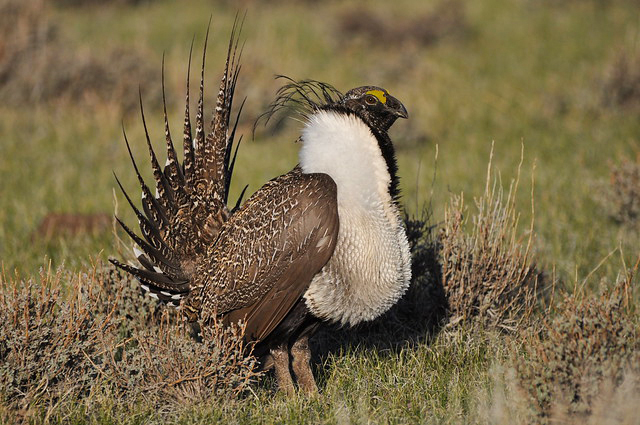WSU study finds silver lining for endangered birds in Washington
Sage-grouse population decrease could have environmental impact
As the variety of natural vegetation decreases, so does the sage-grouse population.
September 23, 2019
The balance and health of ecosystems across the western half of the United States rests on the feathery shoulders of some of the country’s most resilient birds — the sage-grouse.
Sage-grouse play an essential role in Washington state’s many habitats, said Mike Schroeder, the sage-grouse expert at the Washington Department of Fish and Wildlife. They thrived in huge populations before the Lewis-Clark Expedition of the early 19th century replaced their original home in the Columbia Basin with cropland.
A 2019 study published in The Journal of Wildlife Management found sage-grouse that were “translocated,” or moved from one habitat to another, would take about one year to adapt to their new surroundings and would actually survive at the same rates as resident birds. While these findings suggest that the dying sage-grouse population could live outside their native areas, the reality is not so simple, said Kyle Ebenhoch, the lead researcher on the study.
“[Humans and large mammals] can live in the Arctic or in a hotel room,” he said, “but sage-grouse are so sensitive to subtle changes.”
Most of the previous attempts to translocate these birds were unsuccessful, which is why this particular study could have large implications, Ebenhoch said. However, moving these sage-grouse did not augment the population numbers. It only helped the adult birds survive in a different place.
This means the population overall is still experiencing a sharp decline in numbers, a trend that alarmed conservationists back in 1987, the year of the first sage-grouse translocation, Ebenhoch said.
Schroeder has worked with sage-grouse since 1981, and joined the Department of Fish and Wildlife as the sage-grouse expert in 1992. He said the birds have a unique resilience to harsher conditions — they can be found thriving in rugged mountains or munching on sagebrush that’s usually poisonous to other animals.
This volatility makes them a good “indicator” species for the health of not just Washington or the western coast, but the western half of the United States, Schroeder said. That’s also what makes the decline in their populations so alarming.
“And we’re not the exception here,” Schroeder said. “There’s not a lot of options you got at this point.”
Tom Lamar, executive director at the Palouse-Clearwater Environmental Institute, said every animal in an ecosystem affects the health of the entire habitat. When one species goes, others often follow. This is clearly because of human activity and warming temperatures due to climate change, he said.
Along with this, Ebenhoch said human activity often brings invasive species to sage-grouse habitats. Small organisms can stick on the underside of cars or on the sides of boats reaching the Seattle harbor.
Schroeder said major construction developments, like putting up wind turbines or energy plants, can force sage-grouse off land, a big deal for a species with migration distances of only 10 miles.
Lamar said an agricultural area like Pullman or Moscow should encourage natural vegetation to grow for precisely these reasons — invasive species and human-caused habitat changes can completely wipe out essential plants animals rely on.
At the Yakima Training Center, a military base that holds sage-grouse, they would potentially want about 1,200 “displaying” males, or male birds ready to breed. Right now, they have 30. The highest population seen at the YTC was in the 1960s, and the population today is lower than it has ever been, Schroeder said.
Though they can survive under limited conditions, Schroeder said the main problem is space. They need big, healthy habitats to survive and migrate locally, which is an essential part of mating and nesting rituals for them.
“Does the loss [of sage-grouse] have an impact on the habitats? Yes, in ways I don’t think we can even understand yet,” Schroeder said.
The next step for Ebenhoch and Schroeder is adding numbers to a deteriorating population. Schroeder said they could bring in sage-grouse species from Montana, Idaho, Oregon and northern Nevada to breed with Washington sage-grouse, but if that does not work, it could mark the end of the birds.
“We’re kind of getting desperate here,” Schroeder said.











